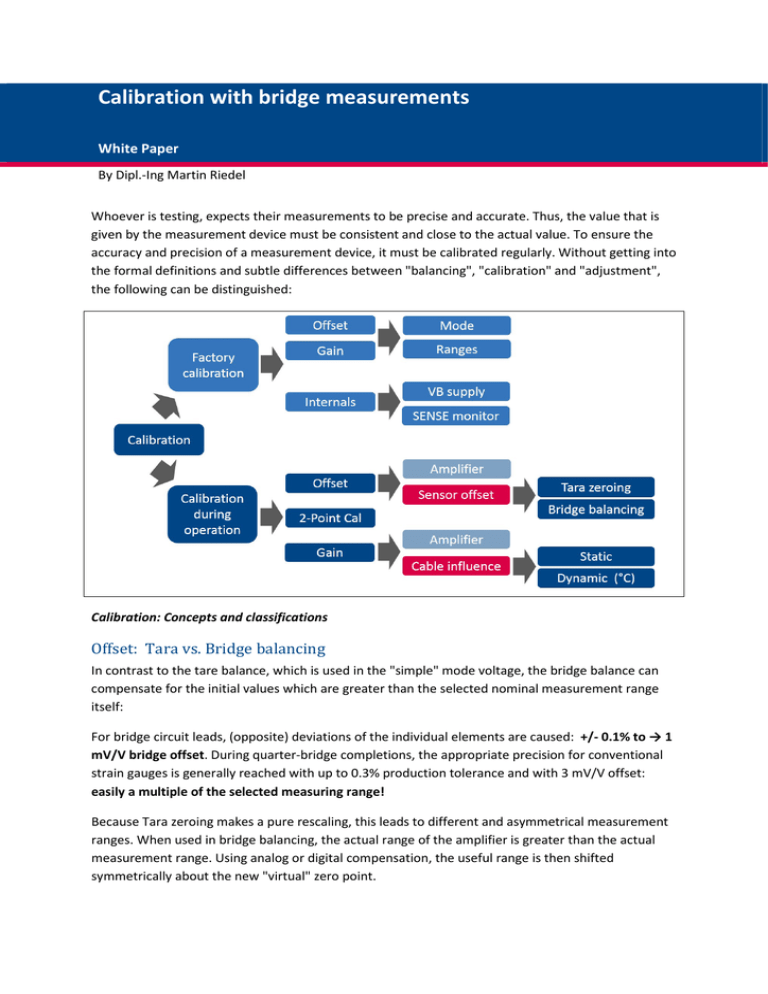
Calibration with bridge measurements
White Paper
By Dipl.-Ing Martin Riedel
Whoever is testing, expects their measurements to be precise and accurate. Thus, the value that is
given by the measurement device must be consistent and close to the actual value. To ensure the
accuracy and precision of a measurement device, it must be calibrated regularly. Without getting into
the formal definitions and subtle differences between "balancing", "calibration" and "adjustment",
the following can be distinguished:
Calibration: Concepts and classifications
Offset: Tara vs. Bridge balancing
In contrast to the tare balance, which is used in the "simple" mode voltage, the bridge balance can
compensate for the initial values which are greater than the selected nominal measurement range
itself:
For bridge circuit leads, (opposite) deviations of the individual elements are caused: +/- 0.1% to → 1
mV/V bridge offset. During quarter-bridge completions, the appropriate precision for conventional
strain gauges is generally reached with up to 0.3% production tolerance and with 3 mV/V offset:
easily a multiple of the selected measuring range!
Because Tara zeroing makes a pure rescaling, this leads to different and asymmetrical measurement
ranges. When used in bridge balancing, the actual range of the amplifier is greater than the actual
measurement range. Using analog or digital compensation, the useful range is then shifted
symmetrically about the new "virtual" zero point.
Tara zeroing
•
Formal rescaling,
only
•
Results in
individually distinct
and asymmetrical
ranges (e.g., -11V
... +9V)
Bridge balancing
•
•
•
Offset can be much
larger than active
measurement
range!
Compensation and
offset shifting
Results in uniform
and symmetric
ranges
(e.g., +/- 2mV/V)
Modern digital concepts (such as imc systems) use high-resolution and stable 24-bit ADC, having
enough headroom to digitize the entire offset signal, yet still providing sufficient resolution for the
high-activity areas being used. Thus, the subtraction of the offset can be purely digital and realized
absolutely drift-free.
Digital bridge balancing
•
•
•
Not depending on ultra-stable
analog summing node – but based
on stable ADC!
Requires ADC to acquire the entire
analog input range
Advanced concept, enabled and
driven by modern ADC technology
with 24 Bit
2
Stability of zeroing/balancing
The fact that the bridge offset can take extremely large values, partly by the way,
perhaps unexpectedly, that the stability of offset compensation with increasing initial offset is also
determined by the gain drift of the system. It is namely subjected to the compensated value! E.g.,:
Initial Offset to be compensated:
Gain drift:
Resulting equivalent offset drift:
2 mV/V @5V according to 10 mV absolute
10 ppm / °C
10 mV * 10 ppm / °C = 0.1 µV / °C
This is in the order of magnitude of a typical amplifier input stages as "direct" offset drift.
Gain error due to cable resistance
Cable resistances in the supply lines cause an attenuation of the sensor actually effective excitation:
After a power divider principle the ratio of bridge impedance to the sum of the cable resistance is
crucial. This "loss" can be compensated by additional sensor leads (SENSE).
E.g.,: The Thinnest wire customary in sensor
instrumentation: Copper size 0.14mm² (equivalent
AWG26)
•
•
•
•
0.14mm² == 130 mΩ / m
10 m lead wire, feed and return lead →
double
Worst case: low impedance bridge (120 Ω
full-bridge → European…)
Typical: 2 x 1.3 Ω / 120 Ω
→approx.
2%
10 m
2 % Gain error
Dynamic cable resistance from temperature drift
Should the unique compensation of the static gain error be performed at the beginning of the
measurement, i.e., after installation, or the must the correction be tracked during the during the
running measurement operation? For outdoor test drive applications, temperature differences of 60
° C could occur, for instance, when the outside temperature in the morning at the start of
measurement is -10 ° C and the by midday the temperature could be upwards of 50 ° C.
The temperature coefficient of copper over 60°C leads to a resistance drift
of:
•
•
•
•
Cu: 4000 ppm/°C (“TK4000”)
∆T = assumed 60°C operating range
4000 ppm * 60°C = 24 %
Thus, the initially matched gain error of 2% changes to :
2 % * 24 % = 0.48 % Gain drift
(10 m cable)
For even longer cables, the it can be even more relevant:
3
4.8 % Gain drift
(100 m cable)
Cable symmetry and simple sensor leads (SENSE)
Since Cables and wires are made from copper, they can be regarded almost always as a good
"match"! Even for other cable types, significant local heating along the cable can still be considered
“perfect.
Also contact resistances of connectors do not essentially disturb the symmetry: Typical values of a
max. of 25 mΩ per contact lead, even when corroded, cab be considered ideal:
Mismatching and gain errors:
25 mΩ / 120 Ω = 0.02 %
Thus:
one single SENSE lead is sufficient!
The compensation takes place in imc systems in
a digitally:
The "basic" cable loss is detected by means of an
additional measurement path and ADC, and
mathematically compensated by twice the
amount - and continuously during operation!
The dynamic compensation also acquires the
temperature-induced drift of cable resistances.
In addition, even the undamped supply is
directly acquired at the amplifier terminals VB to
optimally compensate for even the residual
tolerance.
Digital Single-SENSE compensation
Ratio-metric bridge measurements
In this way a perfect ratio-metric measurement bridge is achieved. Ratio-metric means that the
bridge sensor in terms of "mV / V → mV signal pro V supply voltage" always delivers a fraction of the
supply voltage. A damped supply can thus be compensated for by a purely computational gain
correction. An actual "physical" adjustment of the voltage is to not even necessary. This avoids
additional sources of error or stability problems of analog control loops.
Double SENSE
So then are double-SENSE lines still necessary or even useful?
Apart from rare asymmetrical cases of cable resistances (see above), in particular carrier frequency
modes, the double-SENSE phase relationships are accurately reached.
Dynamic disturbance with half-bridge configuration
Advantageously, double-SENSE configurations can be used in more "exotic" cases where the
likelihood of massive bad contacts or dynamic interference and couplings along the supply lines
occur namely in half-bridge configuration. Why is this only for half-bridge configurations an issue?
4
When using a simple "single-SENSE", on the basis
symmetry, the internal half-bridge completion is always
connected to the internal +/- VB node.
Dynamic disturbance with
half-bridge configuration:
Then unbalanced and dynamic disorders only affect the
external (active) branch of the bridge, but not to the
internal HB completion. While this is still corresponds to
insignificantly small gain errors, this can lead to
observable offset errors or signal jumps.
Because these effects are dynamic in nature, they
cannot be suppressed by (somewhat slower) arithmetic
compensation.
Double-SENSE allows for symmetric +/-SENSE signal
feedback and drives internal HB completion - Perfect for
dynamic (analog) noise cancellation!
Dynamic noise injection or bad contacts on +/- VB
Conclusion: SENSE with imc bridge amplifiers
•
•
•
•
•
imc systems are generally equipped with SENSE line support
Sense lead detects the actual effective supply voltage at the remote sensor
Sense can be implemented with single or double wires:
o Supply cables are symmetric: -> double Sense is usually not necessary
o Economic single-SENSE is an important selling point for imc-modules
o Double SENSE for CF and exotic cases of dynamic disturbances
o The imc amplifier modules BR2-4 and UNI-4 offer both single and double SENSE:
The software automatically detects the current wired configuration
Arithmetic compensation of gain error - automatically in the background
Dynamic adaptive compensation during active measurements even comprises thermal drift
5
Quarter-bridge configuration
In quarter-bridge configuration, both the passive half-bridge completion and the lower
quarter-bridge completion are completed in the amplifier. The strain gauge as the actual fourth
element is connected with two or three (longer and resistance-afflicted) lines.
Next, half of the completed “primitive” 2-wire quarter-bridge circuit is presented. This is not rally of
practical importance since it has dramatic offset and drift problems, as shown in the following
example:
2-wire
•
•
•
•
•
Both cable resistances are associated with upper branch of the
bridge
Cable-resistance e.g., 2 * 10 m, 130 mΩ / m = 2.6 Ω
Gain-error: 2.6 Ω /120 Ω = 2 %
moderate
= ¼ * 2%
Offset-error:
¼ * RK/RB
¼ * 20 mV/V = 5 mV/V
dramatic!
Offset-drift:
with Cu-Drift 4000 ppm / °C* 5 mV/V
= 20 µV/V / °C
FATAL!!
This literally presents a thermometer:
50°C “control” already crosses the 1 mV/V range!!
50 °C * 20 µV/V / °C = 1 mV/V C
In contrast, almost exclusively used 3-wire circuits avoid this offset error due to the symmetrical
distribution of the two cable portions on upper and lower bridge arms:
3-wire
•
wires equally distributed: upper/lower branch
•
Offset and Thermal drift:
•
Gain-error: e.g., (10m ) 2.6 Ω /120 Ω = 2 %
moderate and “initially” uncompensated
compensated
For "conventional" bridge amplifier or relevant competitors, where:
The remaining "moderate" gain error, determined by the ratio of cable resistance to bridge
impedance, initially remains, when the “simple” "3-wire circuit is not taken into account,
uncompensated!
6
It can typically be corrected by methods such as the "shunt calibration" and, in
particular, on the internal quarter-bridge completion.
imc 3-wire quarter-bridge completion (with gain compensation)
While the offset stability of the 3-wire circuit are common property and state of the art, offer imc
systems as an additional unique feature full gain correction for 3-wire circuit. imc systems
additionally offer a unique full gain correction for a 3-wire circuit.
In addition, a separate auxiliary amplifier with ADC is used to acquire the voltage drop along the
“average” return conductor. Since this represents half of the total power loss, it is doubled and used
for the computational gain correction.
Conclusion:
Thus, this dynamic tracking compensation makes any shunt calibration at quarter-bridge unnecessary
and therefore superior.
imc 3-wire quarter-bridge circuit with dynamic gain correction
7
Shunt-calibration
But if, as has been shown here, gain error through SENSE leads (Full- and Half-Bridge)
and (especially with imc systems) and are also fully for the quarter-bridge dynamically acquired and
compensated for, including external influences, then why is Shunt calibration necessary?!
In essence, the Shunt-calibration can provoke a change from, e.g., 0.5 mV/V, essentially to check the
measurement chain qualitatively to ensure that no cable breaks or faulty wiring exists.
If one wanted to correct the device by checking the “internal factors", that is, check or further
improve the factory calibration of the amplifier modules (which, for example, are calibrated at imc to
typ. 0.02%), one would need the high-impedance calibration resistors to be accurate, even with what
is quickly lost due to leakage resistances in the GΩ. It is clear that this is not necessary or can even be
counter-productive.
The case remains in applications with such sensor installations (e.g., from an economic standpoint)
that by using SENSE-cables, even the cable resistance influences will be corrected. As shown below,
even more serious effects of cable resistances can be observed at the measurement input. These
effects actually require a separate supply for the shunt resistance – that does not want or can afford,
but in this case is needed…an apparent dilemma, however a clever solution exists with a new feature
by imc!
In what way cable resistances falsify the shunt calibration? In several ways:
The parallel connection of a shunt directly to the strain gauge
provokes a real signal change that is smaller than is expected;
Because of the attenuation of the power at the remote sensor,
this causes cable resistance at +/- VB.
Magnitude: about Rcable/Rstraingauge
(e.g.,.: circa. 1% at 1.3 Ω / 120 Ω)
However, since the shunt is not locally connected at the remote
sensor, but instead is connected internally in the amplifier, the
shunt is parallel to the sum of the strain gauges and cables.
The ratio of "Bridge to shunt" is thus greater than nominal. Thus,
the real jump is not small, but larger.
8
Another, more and opposite distortion however, is caused by the
cable resistance at the measuring input IN +.
As an example, the 0.5 mV / V jump is achieved with 60 KΩ
(analogous to the quarter-bridge jump = 1/4 * bridge/shunt)
While on the other hand, the ratio is cable / shunt1.3 Ω to 60 KΩ,
thus only 22 ppm. But this voltage divider acts with half-bridge
voltage:
VB/2 * 22ppm = 11µV/V
So instead of the expected attenuation, a further enlargement of
the expected: 0.5mV / V jump by about 2.2%
This could be avoided by a separate supply for the calibration
resistor. However, in general, this additional line is not available!
Cable compensation without SENSE – via shunt calibration
Summing up these connections together in a mathematical model, which (rightly) assumes
symmetrical cables, one can therefore (without additional lines!) calculate the cable resistance and
thus the necessary gain correction from the distortion of calibration jump.
This function, among others, is a corresponding, automatic two-point calibration and is another
exclusive and unique feature of imc amplifiers!
Cable compensation without SENSE – via shunt calibration
9
Additional information:
imc Meßsysteme GmbH
Voltastr. 5
13355 Berlin, Germany
Telephone:
Fax:
E-Mail:
Internet:
+49 (0)30-46 7090-0
+49 (0)30-46 31 576
hotline@imc-berlin.de
www.imc-berlin.com
For over 25 years, imc Meßsysteme GmbH has
been developing, manufacturing and selling
hardware and software solutions worldwide in the
field of physical measurement technology.
Whether in a vehicle, on a test bench or
monitoring plants and machinery – data
acquisition with imc systems is considered
productive, user-friendly and profitable. So
whether needed in research, development, testing
or commissioning, imc offers complete turnkey
solutions, as well as standardized measurement
devices and software products.
imc measurement systems work in mechanical and
mechatronic applications offering up to 100 kHz
per channel with most popular sensors for
measuring physical quantities, such as pressure,
force, speed, vibration, noise, temperature,
voltage or current. The spectrum of imc
measurement products and services ranges from
simple data recording via integrated real-time
calculations, to the integration of models and
complete automation of test benches.
Founded in 1988 and headquartered in Berlin, imc
Meßsysteme GmbH employs around 160
employees who are continuously working hard to
further develop the product portfolio.
Internationally, imc products are distributed and
sold through our 25 partner companies.
If you would like to find out more specific
information about imc products or services in your
particular location, or if you are interested in
becoming an imc distributor yourself, please go to
our website where you will find both a world-wide
distributor list and more details about becoming an
imc distributor yourself:
http://www.imc-berlin.com/our-partners/
Terms of use:
This document is copyrighted. All rights are reserved. Without permission, the document may not be edited, modified or
altered in any way. Publishing and reproducing this document is expressly permitted. If published, we ask that the name of
the company and a link to the homepage www.imc-berlin.com are included.
Despite careful preparation of the content, this document may contain errors. Should you notice any incorrect information,
we ask you to please inform us at marketing@imc-berlin.de. Liability for the accuracy of the information is excluded.
REV: 2015-JAN-12



